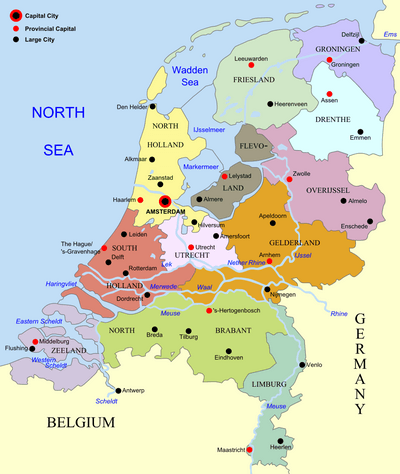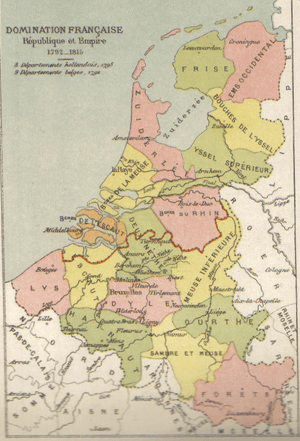Provinces of the Netherlands facts for kids
The Netherlands in Europe are split into twelve areas called provinces. These are known as provincies in Dutch. The Caribbean Netherlands and other countries that are part of the Kingdom of the Netherlands are separate from these European provinces.
Contents
Provinces of the Netherlands
Here are the twelve provinces and their main cities, called capitals:
How Provinces are Governed
A Dutch province is a level of government between the national government and the local towns. Provinces are in charge of things that are important for their whole region.
Each province has three main parts to its government:
- The Provinciale Staten is like the provincial parliament. People vote for its members every four years.
- The Gedeputeerde Staten is a group chosen from the parliament members. They handle most of the daily tasks and decisions.
- The Commissaris van de Koningin (Royal Commissioner) leads this group. This person is chosen by the King or Queen.
A Look Back in Time
Most Dutch provinces started as smaller states in the Middle Ages. These were like counties or duchies. When a powerful ruler took control, these areas became parts of a larger state. They were then called provinces.
In the 16th century, seven northern provinces formed their own country called the Republic of the Seven United Provinces. These were Holland, Zeeland, Gelderland, Utrecht, Friesland, Overijssel, and Groningen. Other areas, like Drenthe and parts of Brabant, Limburg, and Flanders, were also part of the Republic. These were called "conquered lands" and were managed directly by the parliament. They were known as Generality Lands.
On January 1, 1796, Drenthe and Staats-Brabant became new provinces. Staats-Brabant later changed its name to North Brabant in 1815. At this time, the United Kingdom of the Netherlands was formed. This new kingdom included provinces that are now in modern-day Belgium.
Today, the provinces are not independent like they used to be. They are parts of the national government. In 1839, when Belgium became independent, the original province of Limburg was split. Now, both the Netherlands and Belgium have a province called Limburg. A year later, Holland, which was the biggest province, was also split into two: North Holland and South Holland. This made a total of 11 provinces.
The 12th province, Flevoland, was created on January 1, 1986. It's special because most of its land was reclaimed from the sea!
Changes During the French Period
Between 1798 and 1813, when France had a lot of influence over the Netherlands, the country's internal divisions changed. The old provinces were replaced with new areas called "departments." Many of these were named after rivers, just like in France. The idea was to make the country more unified and less about independent provinces.
For example, from 1798 to 1801, the Netherlands was divided into 8 new departments. Later, when the Netherlands became fully part of France in 1810, the departments were renamed again.
However, these changes didn't last long. When the French left in 1813, the old provinces and their names came back. Holland was reunited for a while, and the borders of the provinces were mostly set to what they are today.
See also
 In Spanish: Organizaci%C3%B3n territorial del Reino de los Pa%C3%ADses Bajos para ni%C3%B1os
In Spanish: Organizaci%C3%B3n territorial del Reino de los Pa%C3%ADses Bajos para ni%C3%B1os




